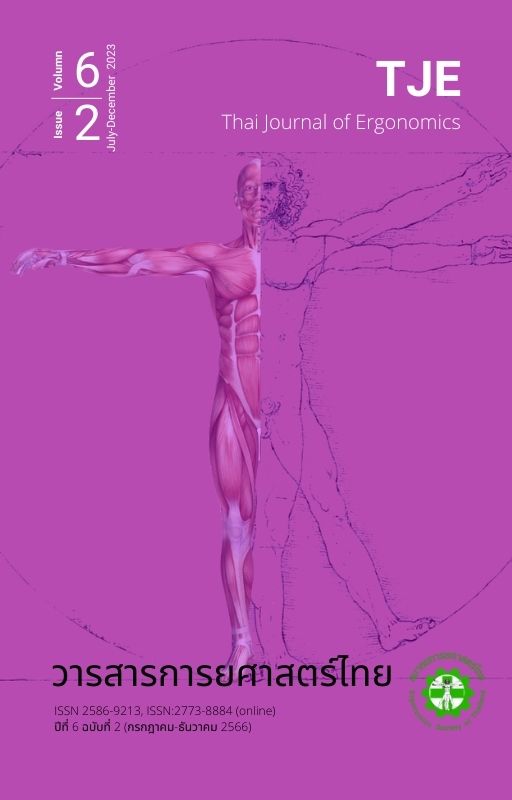A study and tests for the age range at risk to Locomotive syndrome disease by two-step test using new indices
Main Article Content
Abstract
This research aimed to determine the subjects at risk of Locomotive Syndrome in each age range and suggest the guidance of physical activity by using the two-step gait test with a new index from a sample population of 408 subjects. The age range was divided into six categories: 21-30 years, 31-40 years, 41-50 years, 51-60 years, 61-70 years, and 71 years up, each age range consisted of 68 subjects, with 34 females and 34 males. A two-step test score was calculated and 95% confidence interval was determined for declaring the lower and upper bound. The prediction value from multiple linear regression equations was calculated to compare with the lower bound for indicating the risk of Locomotive Syndrome and compare with new indices (Two-step test score < 1.1 and Two-step test score < 1.3). Multiple Linear Regression equation with factors of gender, age range, and levels of exercise activity was analyzed. Binary Logistic Regression was analyzed for determining that gender and age range influence risk of Locomotive Syndrome. The result was found that the sample population in both genders had upper and lower bounds in the same direction, that was the older the age range, the lower the range of 95% confidence interval and the increased risk of Locomotive Syndrome in the older age range. In summary, considering the three factors of gender, age range, and level of exercise, it can be concluded that the subjects had a risk of Locomotive syndrome.
Article Details

This work is licensed under a Creative Commons Attribution-NonCommercial-NoDerivatives 4.0 International License.
References
Yoshimura N, Muraki S, Oka H, Tanaka S, Ogata T, Kawaguchi H, et al. Association between new indices in the locomotive syndrome risk test and decline in mobility: third survey of the ROAD study. J Orthop Sci 2015;20(5):896-905.
การทดสอบความเป็นการกระจายแบบปกติ (Normality Test), วิธีสืบค้นวัสดุสารสนเทศ.[อินเทอร์เน็ต], [เข้าถึงเมื่อ 3 กันยายน 2565]. เข้าถึงได้จาก :http://www.geocitics.ws/chalong_sri/normal_test.htm.
ภาควิชาสถิติ คณะวิทยาศาสตร์ มหาวิทยาลัยศิลปากร“ วิธีการทางสถิติสำหรับวิจัย โดยใช้โปรแกรม SPSS”
วิลาวัลย์ รัตนา. พฤติกรรมการดูแลสุขภาพและการสนับสนุนทางสังคมกับคุณภาพชีวิตผู้สูงอายุโรงพยาบาลสุราษฎร์ธานี” [สารนิพนธ์ปริญญาการศึกษามหาบัณฑิต] มหาวิทยาลัยศรีนครินทรวิโรฒ; 2552.
Imaoka M, Nakao H, Nakamura M, Tazaki F, Hida M, Omizu T, et al. Associations between depressive symptoms and geriatric syndromes in community-dwelling older adults in Japan: A cross-sectional study. Prev Med Rep 2021;22:101353.
Ogata T, Yamada K, Miura H, Hino K, Kutsuna T, Watamori K, et al. Feasibility and applicability of locomotive syndrome risk test in elderly patients who underwent total knee arthroplasty. Mod Rheumatol. 2023;33(6):1197-203.
Ishibashi H. Locomotive syndrome in Japan. Osteoporos Sarcopenia 2018;4(3):86-94.
Matsumoto H, Hagino H, Wada T, Kobayashi E. Locomotive syndrome presents a risk for falls and fractures in the elderly Japanese population. Osteoporos Sarcopenia 2016;2(3):156-63.
Tavares DR, Santos FC. Locomotive syndrome in the elderly: translation, cultural adaptation, and Brazilian validation of the tool 25-Question Geriatric Locomotive Function Scale. Rev Bras Reumatol Engl Ed 2017;57(1):56-63.


